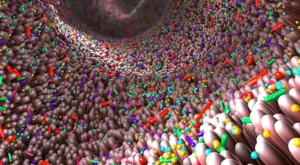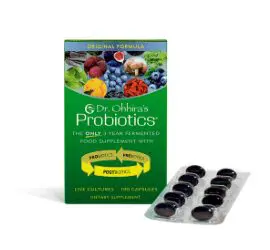Humans have a diverse set of helpful microorganisms living in and on our bodies. This living collection of bacteria, viruses, and yeasts is called our microbiome. In a healthy body, friendly bacteria outnumber pathogenic bacteria to keep the body healthy, a condition called homeostasis. However, when something unbalances the good bacteria, the unfriendly bacteria can take over and cause various unwanted concerns in different body systems, including the skin.
People usually think of the body’s microbiome as being in the gut or intestines because this is where the largest concentration of bacteria lives. However, our skin, the largest organ in our bodies, also has its own microbiome that interacts with the gut microbiome.
Our industrialized world is brutal to our microbial balance. Pollution, a processed-food diet, stress, and medications, especially antibiotics, can disrupt microbiota. Because the gut is connected to other body systems, a microbial imbalance in the gut can affect the skin, causing various concerns.
The Science Behind Probiotics and Skin Health
In the past few decades, scientists have performed over 1,000 recorded studies on probiotics and their impact on different body systems. Some of these studies have focused on probiotics and skin health. Scientists have identified a connection in the body called the gut-skin axis to explain how the gut and skin interact.
The Gut-Skin Axis
Our bodies have a network of nerves that connect the brain and the body. If dysbiosis occurs in the gastrointestinal tract, it may result in inflammatory responses that affect the gut and other organs, such as the skin.
Further, doctors today acknowledge that certain psychological concerns can occur because of poor gut health, manifesting alongside many uncomfortable physical symptoms in the gut.
Likewise, research is connecting mental health concerns and skin disorders in a field of medicine called psychodermatology that studies these connections. Scientists are finding that cause and effect go both ways in the gut-skin axis and that improvements in gut health may improve mental and skin health.
Probiotics in Food vs. Supplements
There are two main ways to consume probiotics – from food or supplements. You have to read labels closely, but you can still find foods fermented in traditional ways to help diversify your microbiome through diet.
Supplements give you more control over what strains you are ingesting, which is particularly useful if you wish to target specific issues.
Consuming Probiotics from Food
Probiotics originate from bacteria that occur naturally in the environment. Our forebears used these microorganisms to preserve food that otherwise would have quickly gone bad.
They introduced bacteria into milk to make yogurt, kefir, and cheese. They infused vegetables with bacterial strains to make cultured foods like sauerkraut and kimchi, and they baked bread using sourdough cultures. What they didn’t know at the time was that these bacteria would have positive impacts on their health.
Consuming Probiotics in Supplement From
When you take a probiotic supplement, the label lists the bacterial strains you are ingesting and any added ingredients. Supplements are convenient and fit into most daily schedules. However, many brands are on the market, and choosing a quality supplement with diverse bacteria and pure, natural ingredients is critical.
Dr. Ohhira’s Probiotic Supplements
Doctor Ohhira creates probiotic supplements that contain multiple strains of beneficial bacteria for intestinal microbiome diversity, a primary attribute of a healthy gut. A combination of ancient Japanese wisdom and up-to-the-minute scientific knowledge has created a highly effective, shelf-stable supplement. The main ingredients are natural foods, and they are fermented for three years in large vats so the bacterial strains learn how to work together.
Even more important is what is left out: chemicals, pesticides, allergens like dairy and gluten, soil-based organisms, and animal byproducts.
Dr. Ohhira’s supplements contain both probiotics and the prebiotics that feed them, resulting in postbiotics, the beneficial metabolites from the activities of the microorganisms. When the whole supplement enters your gastric system, the organisms already know what to do, so the supplements are very effective.
Probiotic Strains and Skin Health
Researchers have tested how probiotics impact the skin using ingested and topically applied probiotics. They have used different strains in studies on various skin concerns. Researchers state, “Probiotics improve immune tolerance, rebalance a healthy inflammatory response, and release important biochemicals such as bacteriocins, modulins, and propionic acid that inhibit the growth of harmful microbes.”
Ingested Probiotics
Several studies have evaluated the impact of ingested probiotics on skin health. While researchers do not consider skin problems gastrointestinal, they acknowledge that the gut’s microbial balance affects the skin.
They have found a connection between gut microbiome imbalance and skin concerns. Here are several species that have indicated positive results when taken orally:
- Lactobacillus acidophilus
- Saccharomyces cerevisiae
- Bifidobacteria
Topical Probiotics
As early as 1912, scientists found positive results in tests of probiotics applied directly to the skin. In later tests around 1999, researchers found that certain microbes, particularly Streptococcus thermophilus, reduced the unfriendly bacteria on the skin and reduced inflammatory responses.
These are a few other species researchers have found have a positive effect on skin health:
- Enterococcus faecalis
- Streptococcus salivarius
- Bifidobacterium longum
- Lactobacillus paracasei
Dr. Ohhira’s Therapeutic Line of Probiotics for Skin Care
As important as it is to add beneficial probiotics to the skin, it is also important to avoid applying substances that disrupt the microbiome. Antibiotic soaps and lotions and harsh scrubbing seem like they would be helpful, but they remove the natural microbial barrier our bodies create.
Dr. Ohhira has created a pure topical skincare line that includes a beauty bar, skin lotion, moisturizer, and a collagen supplement free of added chemicals. We carefully craft each product to preserve the existing microbiome. We then add probiotics and prebiotics that help create a healthy barrier to harmful bacteria and keep cells healthy and skin clear.
Dosage, Duration, and Expectations
In our immediate-gratification society, expecting a supplement to work immediately is natural. You may see positive results when you begin using probiotics topically or internally, but in most cases, it can take eight to twelve weeks or more to see results. It takes time for the healthy bacteria to “set up housekeeping” and produce the postbiotics that confer skin health benefits.
Regarding dosage, read the label of your supplement or topical probiotic product carefully and follow the manufacturer’s instructions.
Potential Side Effects and Interactions
The FDA has said that probiotics are generally considered safe. When you first begin taking a probiotic orally, however, you may temporarily experience gas, changes in stools, or bloating, but these typically go away quickly. If unpleasant symptoms persist beyond two weeks, stop taking the probiotics and see your doctor.
If you are immune-compromised, have recently had a hospital stay, or have a severe health problem, talk to your doctor before taking probiotics.
Regarding topical probiotics, researchers have called out the need to investigate allergic reactions to particular ingredients, and antibiotic resistance transfer among pathogens.
Your Daily Routine: Incorporating Probiotics for Skin Health
We formulate Dr. Ohhira’s skincare line with ingredients that promote overall skin health. You can use it instead of your usual products and know that you are contributing to your skin’s health and not creating additional damage from harsh or antibacterial products.
Dr. Ohhira’s skin care products contain all-natural ingredients, leaving out synthetic fragrances, stabilizers, preservatives, and chemicals. Our unique formulation of prebiotics and probiotics help support the balanced skin microbiome needed to achieve and maintain healthy skin.
FAQs
1. How do probiotics contribute to skin health and the treatment of skin issues?
Stress, poor eating habits, and harsh skincare products, particularly antibacterial soaps, can create an imbalance in the skin’s natural microbiome, enabling unfriendly bacteria to flourish and create unwanted concerns.
Studies show that internal and external probiotics have a place in balancing out the microbiome for healthier skin.
2. Which specific types of probiotics are known to benefit the skin?
Research is ongoing, but several strains have shown positive results.
Orally:
Lactobacillus acidophilus
Saccharomyces cerevisiae
Bifidobacteria
Topically:
Enterococcus faecalis
Streptococcus salivarius
Bifidobacterium longum
Lactobacillus paracasei
3. Can topical probiotics be as effective as oral supplements for skin health?
Researchers have identified the gut-skin axis that explains the connection between the gut and the skin. Studies on oral and topical probiotic supplements have found results from both approaches. Oral probiotics are helpful to improve the microbial balance in the gut, and topical probiotic application directly addresses the skin biome’s health.
A Few Final Words
Research shows that oral and topical probiotics can play a vital role in overall skin health by helping to strengthen or establish a balanced microbiome. If you are experiencing skin issues, talk with your doctor about how probiotics might help improve your skin’s health.
At Essential Formulas, we’re happy to answer any questions you might have. Contact us for more information.




